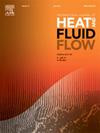Bioinspired spider-web microchannel with five-input-four-output manifold: Enhanced thermal performance for 10,000 kW/m2 chip-scale embedded cooling
IF 2.6
3区 工程技术
Q2 ENGINEERING, MECHANICAL
International Journal of Heat and Fluid Flow
Pub Date : 2025-03-10
DOI:10.1016/j.ijheatfluidflow.2025.109794
引用次数: 0
Abstract
Rapid advancements in high-heat flow density electronic chips have made the enhancement of heat sink thermal performance a crucial aspect of research aimed at efficient chip cooling. This paper uses the structure of a spider web to come up with an embedded flow-shape cooling method that can remove 10,000 kW/m2 of heat. The temperature rise and junction temperature must be less than 60 °C and 85 °C, respectively. We compared two heat sinks with different flow shapes. The heat sinks’ thermal resistance, pressure drop, temperature distribution, temperature rise, junction temperature, and coefficient of performance (COP) of heat dissipation at flow rates of 0.2–0.6 L/min were reported using simulation calculations. As the inlet flow rate went up, the results showed that the temperature distribution became more uniform, and the average outlet temperature, temperature rise, temperature standard deviation, and junction temperature all went down. Notably, the five-input-four-output manifold design exhibited superior heat transfer efficiency and temperature uniformity compared to single-outlet structures, with lower thermal resistance. Under high heat flux conditions, the maximum temperature standard deviation was recorded at 1.18 °C, with a minimum of just 0.2 °C. With a pressure drop of 37.3 kPa and a flow rate of 0.6 L/min, the effective thermal resistance was a mere 0.047 (cm2·°C)/W. However, it is important to note that both radiators saw a bigger pressure drop and a lower COP as a result of the increased flow rate.
求助全文
约1分钟内获得全文
求助全文
来源期刊

International Journal of Heat and Fluid Flow
工程技术-工程:机械
CiteScore
5.00
自引率
7.70%
发文量
131
审稿时长
33 days
期刊介绍:
The International Journal of Heat and Fluid Flow welcomes high-quality original contributions on experimental, computational, and physical aspects of convective heat transfer and fluid dynamics relevant to engineering or the environment, including multiphase and microscale flows.
Papers reporting the application of these disciplines to design and development, with emphasis on new technological fields, are also welcomed. Some of these new fields include microscale electronic and mechanical systems; medical and biological systems; and thermal and flow control in both the internal and external environment.
 求助内容:
求助内容: 应助结果提醒方式:
应助结果提醒方式:


